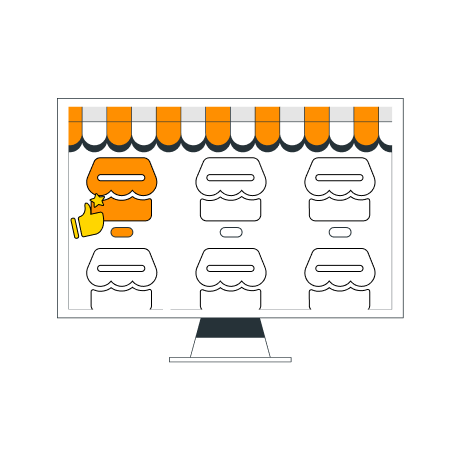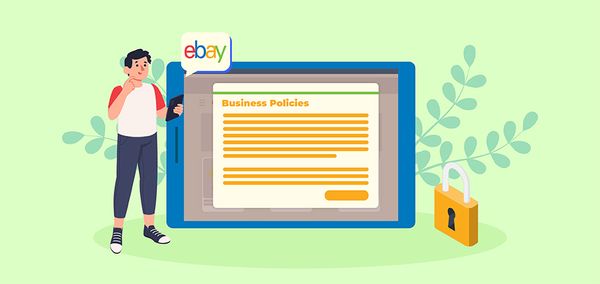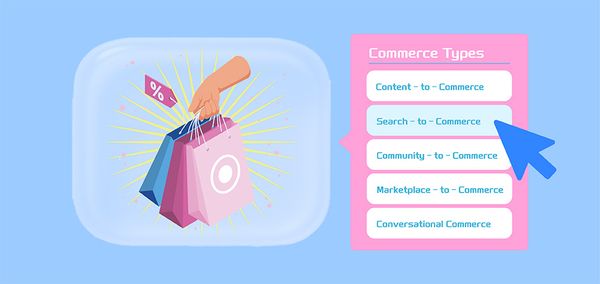8 Most Popular & Profitable Digital Products to Sell in 2024

Updated by March 18,2024
The digital economy is booming, with more and more people turning to the Internet for goods and services. More entrepreneurs are taking advantage by offering digital products that can be easily created and sold online.
So what are the best digital products to sell in 2024 and beyond? Let’s find out in this article!
Understanding the Digital Product Market
Before taking a deeper look at the best digital products to sell in 2024, let's find out some facts and statistics about the digital product market in this part.
Exploring the Digital Product Landscape
Digital products are non-physical goods that are delivered electronically and consumed through internet-enabled devices. They include:
- Information products like ebooks, online courses, webinars
- Software products like SaaS apps, websites, plugins, games
- Media products like audiobooks, video courses, podcasts
Research shows the market for digital goods is booming. According to a study by JPMorgan, over $54 billion was spent on purchasing digital goods like ebooks, apps, online courses, and software in a single year. The same study projects that spending on digital goods will grow by over 36% to $74 billion annually by the year 2025, driven by the rising popularity of internet-enabled devices and the growing availability of digital products
The market for digital products is snowballing driven by several trends:
- Increasing internet and smartphone penetration. More people now have access to consume digital products.
- Rise of the gig economy and freelancing. More people are looking for secondary income sources by selling digital products.
- Declining costs of content creation and distribution. Tools like cameras, editing software, and e-commerce platforms have become more affordable.
- Growth of e-commerce marketplaces. Platforms like Amazon, Udemy, and Etsy give digital product creators access to a large customer base.
- Rising demand for convenience. People prefer consuming information, software, and media products digitally due to their convenience.
- Ability to reach a global audience. Digital products can be sold worldwide through the Internet, expanding the potential customer base.
Advantages of Selling Digital Products
It's easy to see why selling digital products has become so popular with entrepreneurs. Let’s see why:
Low production and distribution costs:
Once a digital product is created, the marginal cost of producing and distributing additional copies is essentially zero. There are no physical goods to manufacture, store or ship. This saves a lot on production and fulfillment expenses compared to physical products.
Scalability and unlimited inventory:
Digital products are infinitely scalable. There is no limit to how many customers can be served since the products exist digitally. This allows digital businesses to grow rapidly without inventory constraints. More customers typically mean more profit, unlike physical products with limited stock.
Profitable Digital Product Categories
Here’s the most important part for anyone who are looking for profitable digital products for their online businesses.
Online Courses and Educational Content
Online courses and educational content is one of the categories that are profitable and easy to sell for any business.
1. Skill-based Courses and Tutorials
Skill-based courses and tutorials provide a hands-on, practical way to learn new skills, satisfy people's innate curiosity, and drive for self-improvement. When packaged and delivered as online courses, they offer an in-demand and potentially profitable digital product for online course creators.
The appeal of the knowledge and skills being taught, combined with the revenue options, lasting value, and broad audience appeal, make them popular choices for many digital entrepreneurs. Some particular products can be listed as below:
- Coding and programming courses
- Photography and photo editing courses
- Design courses
- Language courses
- Musical instrument courses
- …
2. Professional Development Programs
Professional development programs aim to teach practical skills to help professionals advance their careers and earn higher salaries. The credentials and certifications that many of these programs offer further boost their appeal and value. This makes them in-demand digital products for the professionals they target.
So developing high-quality professional development programs around specific niches or professions can be an effective way to create profitable digital products for the online courses and education market. Some detailed products can be:
- Niche certification programs
- Career accelerator programs
- Executive training programs
- Test prep programs
- Consulting accelerator programs
- …
Software and Applications
Software and applications are also a potential category for selling digital products.
3. Productivity Tools and Software Solutions
Productivity tools and software solutions fulfill an essential need for improved efficiency, optimization, and productivity. When this is delivered in the form of digital products, they offer a compelling value proposition for businesses and individuals alike, contributing to their broad popularity and appeal as profitable products.
Some popular products related to productivity tools and software solutions:
- Proposals automation software
- Time tracking software
- CRMs and contact management tools
- Inventory management software
- Accounting and invoicing software
- …
4. Mobile Applications and Plugins
Mobile applications and plugins fulfill users' needs who rely heavily on their mobile devices for productivity, entertainment, and communication. When these needs are fulfilled through useful mobile apps and services, they offer a convenient and immediately valuable digital product, contributing to their popularity and revenue potential.
The key is identifying features, tools, or functionality that would truly enhance people's mobile experience in an existing app category or within a specific platform through a plugin. If done well, these products can succeed as profitable digital ventures.
Some examples of mobile apps and plugins:
- Productivity apps
- News and magazine apps
- Photo editing apps
- Travel apps
- E-commerce plugins
- …
Digital Design Resources
Digital design resources also include several valuable digital products that many customers are looking for. Let’s find out!
5. Graphic Design Templates and Assets
Graphic design templates and assets offer an "accelerator" for designers - helping them produce high-quality designs faster and with less effort. When delivered as digital products that are easy to access and purchase, they fulfill an essential need for busy designers while providing multiple revenue benefits for the providers. These factors contribute to their popularity as profitable digital products within the design resources category.
Some examples of graphic design templates and assets:
- Website templates
- Social media templates
- Logo mockups
- Print templates
- Photoshop actions and brushes
- …
6. Stock Photos and Illustrations
Stock photos and illustrations fulfill an essential need for visual content creators by providing high-quality images they can legally integrate into their designs, posts, presentations, and more.
When these assets are delivered as downloadable digital products at competitive prices, they offer an effective solution to the visual content needs of many businesses and individuals, contributing to their popularity as profitable digital products.
Some digital product samples of this category:
- Stock photos
- Vectors and clip art
- Icon sets
- Backgrounds and textures
- Illustrations
- …
Subscription-Based Content
There’re many digital products in the subscription-based content category that you can refer to. These digital products will bring you a stable income if having proper implementation.
7. Membership Sites and Premium Content Access
Membership sites satisfy people's interests and motivations while providing a valuable revenue model for content providers. When these motivations for self-improvement and community are combined with the benefits of recurring revenue, digital delivery, and global reach, membership and subscription-based content become a popular and profitable choice as a digital product.
Some membership product samples:
- Fitness subscription
- Writer's subscription
- Parenting subscription
- Nutrition subscription
- Travel subscription
- …
8. Exclusive Digital Resources and Updates
Exclusive digital subscriptions satisfy the ongoing needs of businesses and professionals for targeted resources, tools, and knowledge that help them do their jobs better. When bundled into a subscription that justifies its value through regular updates, it becomes an attractive digital product - especially given the revenue stability, low delivery costs, and scaling potential through digital and global distribution.
Examples of exclusive digital resources and updates:
- Industry research subscription
- Designer subscription
- Mobile app updates
- Newsletter subscription
- Stock photo subscription
- …
Creating High-Quality Digital Products
After understanding the digital products that can bring you attractive profits, the next step is understanding how to create high-quality digital products after choosing a category.

|
Find Better Supplier For Products DSers Supplier Optimizer - One click to filter out the most proper suppliers for your products |
Identifying Your Expertise and Target Audience
It all starts with honing in on what makes you an authority in a niche with an underserved market of learners or customers. So know your strengths, passions, and target audience as the foundation for a successful and profitable digital product. To do it, you can try:
Assessing your skills, knowledge, and passion:
- Take stock of areas where you have in-depth knowledge, experience, or skills others may find valuable. This could be a hobby, profession, or specific niche within a field.
- Consider what topics or domains you are genuinely interested in and passionate about. Your enthusiasm will show through the product you create.
- Identify any professional credentials, certifications, or achievements that demonstrate your authority and expertise in a particular area.
Researching and understanding your target market:
- Define who would most benefit from and be interested in the knowledge or resources you can provide. Be as specific as possible in outlining the customer persona.
- Research the needs and pains of your target audience and what comparable solutions already exist. This will help you determine a unique value proposition for your product.
- Look for metrics to understand the size and growth of the potential market you wish to enter. This will affect your go-to-market strategy.
Researching Market Demand and Competition
Once you've identified your expertise and target audience, the next step is researching market demand and competition. This involves:
Analyzing popular digital products in your niche:
- Research the top-selling products in your niche market, including bestsellers on platforms like Amazon, Udemy, Teachable, etc.
- Evaluate what makes these products popular regarding features, structure, pricing, promotion, and customer reviews.
- Identify any gaps or opportunities within these top solutions you can improve upon.
Identifying gaps and opportunities for innovation:
- Look for underserved segments within your target market with fewer options available to them. This indicates a possibility.
- Consider improving existing products by adding new features, reformatting content delivery, adjusting pricing models, etc.
- Think of innovative approaches or unique value you could offer that is genuinely different from what's already on the market.
Ensuring Quality and Value
Once you've identified your niche expertise, target audience, and market opportunities, the next step is ensuring your product delivers high quality and real value. Here’s how:
Focusing on unique and in-demand content:
- Develop content that leverages your particular expertise, knowledge, and perspective within your niche.
- Cover topics and angles that meet your target customer's specific needs and pain points.
- Avoid generic content - aim for targeted depth and practical value.
- Continually ask how your content will improve the lives and work of customers.
Delivering a comprehensive and well-structured product:
- Include all relevant topics, tools, and resources to provide a complete learning experience.
- Organize content in a logical sequence that builds skills and knowledge over time.
- Craft actionable takeaways and next steps in each part of the product.
- Eliminate unnecessary or redundant content.
- Aim for conciseness without sacrificing depth.
Packaging and Pricing Strategies
How you present - both visually and monetarily - and market your digital product sends a strong message to customers about what kind of experience to expect. Professional, simple yet compelling packaging combined with a fair price point that matches perceived value will set you apart and maximize the revenue potential of your products.
So take time to research the packaging and pricing strategies. You can refer to some guides below:
Packaging Your Digital Product
A visually appealing design, easy navigation, and clear demonstration of value are essential elements of product packaging that will resonate with customers and maximize sales.
Creating visually appealing and professional designs:
- Choose a color scheme and fonts that match your brand aesthetics.
- Include high-resolution images that support and enhance your content.
- Create headers, section dividers, and other design elements for a polished look.
- Professionally edit any videos that are part of your product.
- Use templates for a modern and clean design across all your materials.
Organizing content for easy navigation and consumption:
- Group content into logical modules, sections, and lessons.
- Use headings, subheadings, and bullet points to break up content.
- Include a clear table of contents or module overview.
- Implement a simple but intuitive course or membership site structure.
- Use filters and search functions for large amounts of assets or resources.
Determining the Pricing Strategy
Research similar products, assess your own costs and value propositions thoroughly and test various pricing options to determine the strategy that maximizes revenue and profit potential while satisfying customers within your target market.
Conducting market research on similar products:
- Study the prices competitors charge for comparable digital products.
- Look at prices for both high-end and low-end options within your niche.
- Examine if certain pricing tiers seem to be more effective or popular.
- Evaluate which factors seem to justify higher or lower pricing.
Assessing production costs, value provided, and target market:
- Identify your own direct and indirect costs associated with creating the product.
- Determine the ongoing costs to maintain and update the product.
- Estimate the tangible and intangible value the product will provide customers.
- Consider the budget and purchasing power of your target market.
- Set a price that balances producing a profit with providing good value.
Offering Tiered Pricing and Upselling Options
Offering tiered packages, product bundles, and helpful add-ons can unlock higher profits from your most valuable customers willing to pay more. But the tiers and upsells must align with the different needs within your target market to be effective. Some tactics for implementing tiered pricing and upselling:
Creating different product packages with varied features:
- Basic/Standard - Includes core features and benefits
- Premium - Adds advanced or expanded features
- Elite/VIP - Includes all features plus exclusive perks
Implementing upsells or add-ons to increase customer value:
- Additional content or resources
- Support/coaching services
- Customization options
- Premium assets or templates
- Exclusive community access
Selecting the Right Distribution Platform
Choosing the right distribution platform for selling digital products is one of the indispensable steps that you should not miss. The tips below will help you out:
Evaluating Digital Product Marketplaces
Researching platform popularity, assessing key features, audience potential, and revenue models are all important factors to evaluate when choosing a digital product distribution platform.
- Research popular platforms: Check out the major players like Gumroad, Teachable, Udemy, Amazon's Kindle Store, etc. Look at what they offer and who their target audience is. This will give you an idea of your options.
- Assess platform features: Look at what each platform offers regarding functionality. Ensure a platform has the features you need to distribute your specific digital product type.
- Evaluate audience reach: Different platforms have different-sized audiences. Consider how many potential customers each platform can expose your product to. A larger audience size generally means more potential sales.
- Analyze revenue sharing: Check the revenue split between you and the platform. Typically you'll make around 70-80% of sale revenues, while the platform takes a 20-30% cut. Compare revenue shares across platforms.
Building a Dedicated Website or Online Store
Besides evaluating and picking a platform for selling your digital products, you can try to build your own website or online store to sell.
Choosing a user-friendly website builder or content management system:
There are many options for building an online store like Wix, Shopify, WordPress, Square Online Store, etc. Look for one that has eCommerce features built-in and is easy to use, especially if you don't have development experience.
Customizing the website design and optimizing for conversions:
Make sure the design matches your brand and product. Use colors, images, and layouts that align with your target audience and positioning. Design for a seamless customer experience from browsing to checkout.
Focus on usability and clarity throughout the site. Use call-to-action buttons, product descriptions, and review/social proof to encourage buyers. Have a simple checkout process with options like a one-click purchase. Offer incentives like coupons, loyalty programs, and free bonuses.
Conclusion
Selling digital products can be a lucrative business opportunity, especially as more consumers purchase online. The 8 digital product types listed are among the best digital products to sell for entrepreneurs in 2024 and beyond. With hard work, persistence and a customer-focused mindset, digital products can form the basis for a sustainable business. Find out more unique ideas for your online businesses on DSers Blog.












 Company
Company
 Why Choose DSers
Why Choose DSers
 Blog
Blog
 Help Center
Help Center




 Live Chat
Live Chat